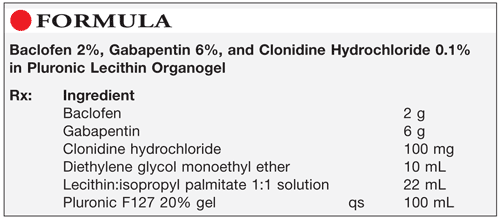US Pharm. 2010;35(11):92-93.

Method of Preparation: Note: The lecithin:isopropyl palmitate solution may be prepared by mixing 0.2 g sorbic acid, 50 g soy lecithin, and 50 g isopropyl palmitate. The Pluronic F127 solution may be prepared by mixing 0.2 g potassium sorbate, 30 g Pluronic F127, and sufficient purified water to make 100 mL.
Calculate the required quantity of each ingredient for the total amount to be prepared. Accurately weigh or measure each ingredient. Mix the powders together. Add the diethylene glycol monoethyl ether and mix to form a smooth paste. Add the lecithin:isopropyl palmitate solution; mix well. Add sufficient additional Pluronic F127 20% gel to volume and mix thoroughly, using a mechanical shearing force. Package and label.
Use: This transdermal preparation is used in the treatment of neuropathic pain.
Packaging: Package in tight, light-resistant containers.
Labeling: Keep out of the reach of children. For external use only. Discard after ____ [time period].
Stability: A beyond-use date of up to 30 days may be used for this preparation.1
Quality Control: Quality-control assessment can include theoretical weight compared with actual weight, pH, specific gravity, active drug assay, color, texture-surface, texture-spatula spread, appearance, feel, rheologic properties, and physical observations.2
Discussion: A number of different drug combinations are used in the transdermal treatment of neuropathies. The specific combination depends upon the patient's needs and the physician's preferences and experiences. The patient should be counseled that as this preparation is rubbed into the skin, it warms up, which may make it slightly more viscous and resistant to rubbing.
Baclofen (Lioresal, C10H12ClNO2, MW 213.66) occurs as a white to off-white, crystalline powder that is odorless or nearly odorless. It is slightly soluble in water. Baclofen is a gamma-aminobutyric acid (GABA) derivative used as a skeletal muscle relaxant. It reduces the frequency and amplitude of muscle spasms (tonic reflexes) that arise in response to muscle stretching in patients with various spinal cord lesions.1,3
Gabapentin (cyclohexaneacetic acid, Neurontin, C9H17NO2, MW 171.24) occurs as a white to off-white, crystalline solid that is freely soluble in water and in alkaline and acidic solutions. Gabapentin is an anticonvulsant agent that is structurally related to GABA. It is used in combination with other anticonvulsants in the management of seizure disorders, neuropathic pain, and vasomotor symptoms.1,4
Clonidine hydrochloride (C9H9Cl2N3.HCl, MW 266.6) is a central alpha-2 adrenergic agonist that occurs as a white or almost white, crystalline powder. It is soluble 1 in 13 mL water and in dehydrated alcohol and is slightly soluble in chloroform.1
Diethylene glycol monoethyl ether (ethoxydiglycol, Carbitol, Transcutol, C6H14O3, CH2OHCH2OCH2CH2OC2H5, MW 134.20) occurs as a colorless liquid with a mild, pleasant odor. It is hygroscopic and miscible with water and common organic solvents. It is nonirritating and nonpenetrating when applied to human skin and is used as a solvent, solubilizer, and cosurfactant.5
Lecithin (egg lecithin, soybean lecithin, vegetable lecithin) describes a complex mixture of acetone-insoluble phosphatides in combination with triglycerides, fatty acids, and carbohydrates. Lecithin ranges from a viscous semiliquid to a powder. It is practically insoluble in water, polar solvents, and cold vegetable and animal oils; when mixed with water, however, it hydrates to form emulsions. Lecithin is soluble in aliphatic and aromatic hydrocarbons, mineral oil, and fatty acids.6
Isopropyl palmitate (C19H38O2, MW 298.51) is a colorless, mobile liquid with a faint odor. It is used as an emollient, oleaginous vehicle, and solvent. Isopropyl palmitate is soluble in acetone, castor oil, cottonseed oil, alcohol, and mineral oil. It is insoluble in water, glycerin, and propylene glycol.7
Pluronic F127 (poloxamer) is a block copolymer of ethylene oxide and propylene oxide. The pH of a 2.5% w/v aqueous solution is in the range of 6.0 to 7.4. Poloxamer 407 (Pluronic F127) is generally available in powdered form. It is freely soluble in water, alcohol, and isopropyl alcohol.8
REFERENCES
1. USP Pharmacists' Pharmacopeia. 2nd ed. Rockville, MD: US Pharmacopeial Convention, Inc; 2008:775-779,1425,1432,1439.
2. Allen LV Jr. Standard operating procedure for performing physical quality assessment of ointments/creams/gels. IJPC. 1998;2:308-309.
3. McEvoy GK. AHFS 2010 Drug Information. Bethesda, MD: American Society of Health-System Pharmacists; 2010:1402-1405,2267-2272.
4. Sweetman SC, ed. Martindale: The Complete Drug Reference. 36th ed. London, England: Pharmaceutical Press; 2009:482-484.
5. Ash M, Ash I. Handbook of Pharmaceutical Additives. Brookfield, VT: Gower Publishing Ltd; 1995:484.
6. Sheng JJ. Lecithin. In: Rowe RC, Sheskey PJ, Quinn ME, eds. Handbook of Pharmaceutical Excipients. 6th ed. London, England: Pharmaceutical Press; 2009:385-387.
7. Taylor AK. Isopropyl palmitate. In: Rowe RC, Sheskey PJ, Quinn ME, eds. Handbook of Pharmaceutical Excipients. 6th ed. London, England: Pharmaceutical Press; 2009:350-351.
8. Collett JH. Poloxamer. In: Rowe RC, Sheskey PJ, Quinn ME, eds. Handbook of Pharmaceutical Excipients. 6th ed. London, England: Pharmaceutical Press; 2009:506-509.
To comment on this article, contact rdavidson@uspharmacist.com.





